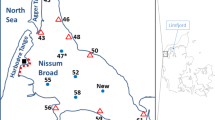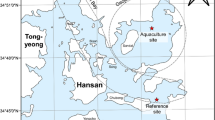Abstract
Mercury concentrations in oysters from four estuaries in northeastern Brazil varied following source changes during the past 13 years. Concentrations were higher in urban estuaries relative to rural areas, but decreased in the 13-years interval following improvements in solid wastes disposal and sewage treatment. In rural estuaries, the one located in an environmental protection area showed no changes in Hg concentrations in the period. However, in the Jaguaribe estuary, remobilization from soils and sediments due to regional environmental changes, increased Hg concentrations in oysters to values similar to the most contaminated metropolitan sites.


Similar content being viewed by others
References
Aguilar CA, Montalvo C, Rodríguez L, Cerón JG, Cerón RM (2012) American oyster (Crassostrea virginica) and sediments as a coastal zone pollution monitor by heavy metals. Inter J Environ Sci Technol 9:579–586
ANVISA (1998) Agência Nacional de Vigilância Sanitária. Port. no 685, 27 agosto, 1998 http://bvsms.saude.gov.br/bvs/saudelegis/anvisa/1998/prt0685_27_08_1998_rep.html. Assessed 15 Mar 2016
BCS (2007) Human health risk assessment of mercury in fish and health benefits of fish consumption. Bureau of Chemical Safety, Food Directorate, Health Products and Food Branch, Ontario. http://hc-sc.gc.ca/fn-an/pubs/mercur/merc_fish_poisson_e.html. Assessed 21 Feb 2016
Bilandzic N, Sedak M, Calopek B, Dzafic N, Ostojic DM, Potocnjak D (2015) Metal content in four shellfish species from the Istrian coast of Croatia. Bull Environ Contam Toxicol 95:611–617
Cavalcanti AD (2003) Monitoramento da contaminação por elementos traço em ostras comercializadas em Recife, Pernambuco, Brasil. Cad Saúde Públ 19:1545–1555
Choi HG, Moon HB, Choi M, Yu Y, Kim SS (2010) Mussel watch program for organic contamiants along the Korean coast, 2001–2007. Environ Monit Assess 169:473–485
Costa BGB, Lacerda LD (2014) Mercury (Hg) in fish consumed by the local population of the Jaguaribe River Lower Basin, Northeast Brazil. Environ Sci Pollut Res 21:13335–13341
Costa MF, Paiva E, Moreira I (2000) Total mercury in Perna perna mussels from Guanabara Bay-ten years later. Sci Tot Environ 261:69–73
Curtius AJ, Seibert EL, Fiedler HD, Ferreira JM, Vieira PHF (2003) Avaliando a contaminação de elementos traço em atividades de maricultura. Resultados parciais realizados em um estudo de caso na Ilha de Santa Catarina, Brasil. Quím Nova 26:44–52
Deepask (2016) http://www.deepask.com/goes?page=Esgoto-tratado:-Veja-o-volume-total-em-metros-cubicos-na-sua-cidade. Assessed 15 Mar 2016
Fortaleza (2014) Prefeitura Municipal. Secretaria Municipal de Urbanismo e Meio Ambiente. Plano municipal de saneamento básico de fortaleza convênio de cooperação técnica entre companhia de água e esgoto do Ceará—CAGECE e Agência Reguladora de Fortaleza—ACFOR. Fortaleza, p 280. http://www.fortaleza.ce.gov.br/sites/default/files/diagnostico_ses_pmf_completo.pdf. Assessed 15 Mar 2016
Frati L, Brunialt G (2006) Long-term biomonitoring with lichens: comparing data from different sampling procdedures. Environ Monit Assess 119:391–404
Garcá-Rico L, Tejeda-Valenzuela L, Burgos-Hernández A (2010) Seasonal variations in the concentrations of metals in Crassostrea corteziensis from Sonora, Mexico. Bull Environ Cont Toxicol 85:209–213
Jara-Marini ME, Soto-Jiménez MF, Páez-Osuna F (2008) Trace metal accumulation patterns in a mangrove lagoon ecosystem, Mazatlan Harbour, SE Gulf of California. J Environ Sci Health A 43:1–11
Jeng MS, Jeng WL, Hung TC, Yeh CY, Tseng RJ, Meng PJ, Han BC (2000) Mussel watch: a review of Cu and other metals in various marine organisms in Taiwan, 1991–1998. Environ Pollut 110:207–215
Joris CR, Holsbeek L, Otchere FA (2000) Hg in bivalves Crassostrea tulipa and Perna perna from Ghana. Mar Pollut Bull 40:457–460
Kehrig H, Costa M, Moreirac I, Malm O (2006) Total and methyl mercury in different species of mollusks from two estuaries in Rio de Janeiro State. J Braz Chem Soc 17:1409–1418
Lacerda LD, Molisani MM (2006) Three decades of Cd and Zn contamination in Sepetiba bay, SE Brazil evidence from the mangrove oyster Crassostrea rhizophorae. Mar Pollut Bull 52:974–977
Lacerda LD, Sena DD (2005) Estimativas de cargas de nitrogênio, fósforo e metais pesados de interesse ambiental para as bacias inferiores do litoral do Estado do Ceará. Secretaria de Meio Ambiente do Estado do Ceará, programa Zoneamento Ecológico e Econômico do Litoral do Ceará, Fortaleza, p 84. https://www.semace.ce.gov.br
Lacerda LD, Soares TM, Costa BGB, Godoy MDP (2011) Mercury emission factors from intensive shrimp aquaculture and its relative importance to the Jaguaribe River Estuary, NE Brazil. Bull Environ Contam Toxicol 87:657–661
Lacerda LD, Dias FJS, Marins RV, Soares TM, Godoy JM, Godoy MLDP (2013) Pluriannual watershed discharges of Hg into a tropical semi-arid estuary of the Jaguaribe River, NE Brazil. J Braz Chem Soc 24:1719–1731
Marins RV, Paula Filho FJ, Lacerda LD, Rodrigues SR, Marques WS (2004) Distribuição de mercúrio total como indicador de poluição urbana e industrial na costa brasileira. Quím Nova 27:763–770
Meyer U, Hagen W, Medeiros C (1998) Mercury in a northeastern Brazilian mangrove area, a case study: potential of the mangrove oyster Crassostrea rhizophorae as bioindicator for mercury. Mar Biol 131:113–121
Newman MC, Unger MA (2002) Fundamentals of ecotoxicology. Lewis Publishers, Boca Raton
NOAA (2016) Center for coastal monitoring and assessment, Mussel Watch Program. http://coastalscience.noaa.gov/about/centers/ccma. Assessed 12 Feb 2016
Olivares-Rieumont O, Lima L, Rivero S, Graham DW, Alonso-Hernandez C, Bolaño Y (2012) Mercury levels in sediments and mangrove oysters, Crassostrea rizophorae, from the North Coast of Villa Clara, Cuba. Bull Environ Contam Toxicol 88:589–593
Páez-Osuna F, Osuna-Martínez CC (2015) Bioavailability of cadmium, copper, mercury, lead, and zinc in subtropical coastal lagoons from the Southeast Gulf of California Using mangrove Oysters (Crassostrea corteziensis and Crassostrea palmula). Arch Environ Cont Toxicol 68:305–316
Porte C, Barceló D, Tavares TM, Rocha VC, Albaigés J (1990) The use of the mussel watch and molecular marker concepts in studies of hydrocarbons in a tropical bay (Todos os Santos. Bahia, Brazil). Arch Environ Cont Toxicol 19:263–274
Sartori AGO, Amâncio RD (2012) Pescado: importância nutricional e consumo no Brasil. Segurança Alimentar Nutr 19:83–93
Sparks C, Odendaal J, Snyman R (2014) An analysis of historical Mussel Watch Programme data from the west coast of the Cape Peninsula, Cape Town. Mar Pollut Bull 87:374–380
Tripp B (1993) The International Mussel Watch. A global assessment of environmental levels of chemical contaminants. Initial implementation phase, draft final report. Woods Hole Coastal Research Center. https://openlibrary.org/works/OL16501723W/The_Inteernational_mussel_watch
USEPA (2000) Guidance for assessing chemical contaminant data for use in fish advisories. Vol. 1: fish sampling and analysis. EPA 823-B-00-007. Office of Science and Technology Office of Water U.S Enviromental Protection Agency, Whashington
Vaisman AG, Marins RV, Lacerda LD (2005) Characterization of the mangrove oyster Crassostraea rhizophora, as a biomonitor for mercury in tropical estuarine systems. Bull Environ Cont Toxicol 73:582–588
van Dijka C, van Doomb W, van Alfena B (2015) Long term plant biomonitoring in the vicinity of waste incinerators in The Netherlands. Chemosphere 122:45–51
Yamashita Y, Omura Y, Okazaki E (2005) Total mercury and methylmercury levels in commercially important fishes in Japan. Fish Sci 71:1029–1035
Acknowledgments
Funding was provided by by CNPq-INCT-TMCOcean Project (Proc. No. 573.601/2008-9), And CNPq/ANA (Proc. No. 445.779/2015-2).
Author information
Authors and Affiliations
Corresponding author
Rights and permissions
About this article
Cite this article
Rios, J.H.L., Marins, R.V., Oliveira, K.F. et al. Long-Term (2002–2015) Changes in Mercury Contamination in NE Brazil Depicted by the Mangrove Oyster Crassostraea rhizophorae (Guilding, 1828). Bull Environ Contam Toxicol 97, 474–479 (2016). https://doi.org/10.1007/s00128-016-1855-y
Received:
Accepted:
Published:
Issue Date:
DOI: https://doi.org/10.1007/s00128-016-1855-y




